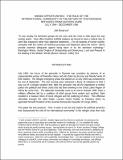| dc.contributor.author | Boutroue, Joel | |
| dc.date.accessioned | 2015-06-22T17:13:11Z | |
| dc.date.available | 2015-06-22T17:13:11Z | |
| dc.date.issued | 1998-06 | |
| dc.identifier.uri | http://hdl.handle.net/1721.1/97503 | |
| dc.description.abstract | July 1994, the horror of the genocide in Rwanda was overtaken by pictures of an unprecedented exodus of Rwandan Hutus, led into Zaire by the iron and bloody hands of their leaders. The refugee emergency phase that started on 13 July 1994 was contained by the end of September. The two ensuing years witnessed a flurry of initiatives to find a way out of a refugee situation that, after the genocide, had all the ingredients to further poison the political and ethnic crises that had been brewing in the Great Lakes Region of Africa for some time. The stalemate eventually came to an end in October 1996, when a military offensive led by a coalition of rebel groups from eastern and southern Zaire resulted in a massive return of some refugees and the scattering of others. This offensive ultimately brought the rebel leader, Laurent Desire Kabila, to Kinshasa where he appointed himself President of the renamed Democratic Republic of Congo (DRC). | en_US |
| dc.language.iso | en_US | en_US |
| dc.publisher | Inter-University Committee on International Migration | en_US |
| dc.relation.ispartofseries | Rosemarie Rogers Working Paper Series;1 | |
| dc.title | Missed Opportunities: The Role of the International Community in the Return of the Rwandan Refugees from Eastern Zaire, July 1994 - December 1996 | en_US |
| dc.type | Working Paper | en_US |
